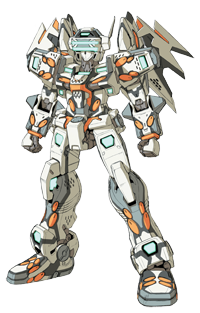 I first played Virtual On years ago now, originally on the Saturn port in fact. I look back at that with some disdain admittedly, as I later but quickly realised that the arcade original, with its wondrous twinstick control setup, was a far superior game. The arcade version took me a few months of practice to get into, mainly because the nearest arcade was an hour’s train ride away and I was still at the tender age that meant I didn’t have a driving license.
I first played Virtual On years ago now, originally on the Saturn port in fact. I look back at that with some disdain admittedly, as I later but quickly realised that the arcade original, with its wondrous twinstick control setup, was a far superior game. The arcade version took me a few months of practice to get into, mainly because the nearest arcade was an hour’s train ride away and I was still at the tender age that meant I didn’t have a driving license.
Once I’d learnt the basics I decided to create a club in a fairly central London arcade (London being in the UK, in case you’re wondering). It was imaginatively titled the London Virtual On Club, or LonVOC for short.
It then appeared that my practice had been pretty thorough, as my subsequent skills were rather potent against the new club members (all of whom were keen to best me, but in the non-Xbox Live smacktalk sense). We were also later graced with the only arcade cabinet of Virtual On Oratorio Tangram (M.S.B.S. 5.2) in the UK, which was a lot of fun.
Considering the recent announcement of Oratorio Tangram coming to digital download, it seems only fair to cover a series that made me travel halfway across my native country just to plumb credits into an arcade cabinet (a cabinet I later ended up owning, as you probably know already).
Dennou Senki Virtual On (1995)
 The original Virtual On had a very difficult birth, more than many probably realise. Up and till this point SEGA had used their Model 2 hardware in quite a rigid fashion in terms of gaming functionality.
The original Virtual On had a very difficult birth, more than many probably realise. Up and till this point SEGA had used their Model 2 hardware in quite a rigid fashion in terms of gaming functionality.
The reason for this was that the bulk of the processing power was in the rendering than anything else. So whilst the games had beautifully textured polygons, they couldn’t do much with them. This is why a lot of the earlier Model 2 games felt quite on-rails. So the simplicity behind Sega Rally’s beautiful handling and Virtua Cop’s point and shoot approach where dictated by the hardware, not design.
Cue Juro Watari and the premise of having an arena based fighting game where the player could dash at blinding speed wherever they wanted. Unsurprisingly, the early vestiges of Virtual On where almost canned but Hisao Oguchi (then a producer) joined forces to prove it could be done.
The biggest problem the team faced was that Model 2 hardware had real problems with updating the position of complex animated objects. In Virtua Fighter the movement was relatively slow and the arena quite small, so this limitation wasn’t really an issue. In Virtual On, with complicated robots dashing at high speeds things got very difficult.
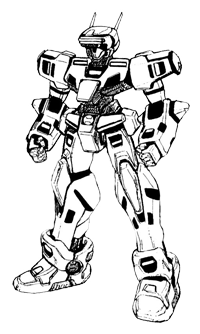 The initial hit was the robots themselves, it was clear even in early stages that they needed very low-polygon models for the titular Virtuaroids or VRs. The problem with mecha design at that time is that it didn’t really do simple. They were complex multi-jointed machines with a huge amount of geometrical detail. So Katoki Hajime, renowned for his gritty real robot designs, was called into help. His simple and highly stylised designs helped get the game running, as well as give the title an iconic aesthetic.
The initial hit was the robots themselves, it was clear even in early stages that they needed very low-polygon models for the titular Virtuaroids or VRs. The problem with mecha design at that time is that it didn’t really do simple. They were complex multi-jointed machines with a huge amount of geometrical detail. So Katoki Hajime, renowned for his gritty real robot designs, was called into help. His simple and highly stylised designs helped get the game running, as well as give the title an iconic aesthetic.
The next problem was handling how to update two VRs positions on the fly. This is where things get interesting.
One of the most important aspects of the original Virtual On was down to the fixed length dashes the VRs did. Initiating a dash and then pressing one of the attack triggers would have your VR face your opponent and fire. Making sure you got the right angle on your target was also crucial. In addition, at the end of each dash the VR would freeze in position, leaving the player vulnerable. So what followed was a tactical wrong footing of each player as they tried to catch one another at the end of their dashes. This became known as thrust vectoring amongst the fans.
This core aspect of the game was another happy accident and borne from the limitations of what the Model 2 board could handle. The fixed dashes were admittedly one design solution for the technical limitations (as it only had to have the hardware calculate a start and an end point) but the dash freeze occurred down to the hardware needing time to update the position of the VR.
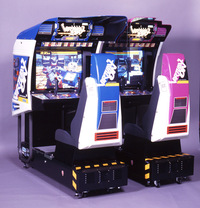 I asked Watari several years ago, how he best described the mechanics in Virtual On and his answer was that it was akin to Noh theatre being crossed with American Football; fixed rigid motions coupled with complex arena based tactics.
I asked Watari several years ago, how he best described the mechanics in Virtual On and his answer was that it was akin to Noh theatre being crossed with American Football; fixed rigid motions coupled with complex arena based tactics.
Not a bad analogy really.
There is one other technical aspect I haven’t covered though; the twinsticks.
Why use a tank control setup for high speed vectored dash based combat? You’ll only think that if you look upon Virtual On’s mechanics in a visual sense. Due to limitations of the hardware, the game needed a very precise form of control input for the movement commands. If you’re going to be penalised with immobility at the end of a dash you want to make sure that you wanted to dash in that direction in the first place. The twinsticks were the solution to this potential disastrous lack of precision.
The important part of the twinstick setup was at the base of each stick. However, to limit as much of an input deadzone as possible the stick was lengthened to take advantage of its leverage. So the player only needed to register a small movement with the sticks and the leverage would amplify that to the already sensitive electronics at the base. Basically, a very low-tech solution for a then cutting edge problem.
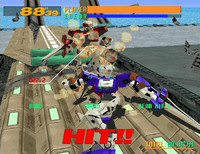 The only way to make doubly sure that your inputs made it into game as intended was manifested as a literal doubling of input; two sticks. Each stick acted as backup for the other in terms of your direction controls. Admittedly, you could pivot on the spot like a tank by pushing the sticks in opposing vertical directions but that was more of an easter egg rather than anything actually useful.
The only way to make doubly sure that your inputs made it into game as intended was manifested as a literal doubling of input; two sticks. Each stick acted as backup for the other in terms of your direction controls. Admittedly, you could pivot on the spot like a tank by pushing the sticks in opposing vertical directions but that was more of an easter egg rather than anything actually useful.
This is why playing the recent SEGA AGES port on a pad is akin to fondling a restless ferret through a wet towel and why Marz had such problems but more of that later.
Some may think that Virtual On’s twinstick setup came from Cyber Sled and to an extent this is half true, as the controls were a partial inspiration. The big difference is that Cyber Sled was trying to emulate futuristic tank combat (so no fixed dashes basically) rather than anything mecha related.
Virtual On turned out to be a massive success and catapulted both Watari and Oguchi into the internal corporate limelight. The game was also ported over to the Saturn and PC but with mixed results, as mapping the hardware limitations intentionally onto other platforms proved very awkward. To the extent that the Saturn port was mechanically very different, as dash freeze was massively reduced. However, when a line of new arcade boards was announced in the form of Model 3 the Virtual On team were assembled once again.
Dennou Senki Virtual On Oratorio Tangram (1998)
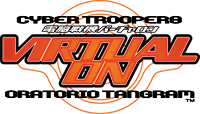 The name Oratorio Tangram, or just Oratan to the fans, was birthed as means to describe what the game was. Oratorio being a holy opera and a tangram being a Chinese puzzle based around arranging shapes, the name essentially signified that the game was meant to be a “grand remix” of sorts. It’s an apt name as the changes to the game were legion.
The name Oratorio Tangram, or just Oratan to the fans, was birthed as means to describe what the game was. Oratorio being a holy opera and a tangram being a Chinese puzzle based around arranging shapes, the name essentially signified that the game was meant to be a “grand remix” of sorts. It’s an apt name as the changes to the game were legion.
Now with far more potent hardware, a lot of the limitations that defined the core mechanics of the first game were no longer really present. That said, some were still artificially retained as they still gave meaningful structure to the game. Specifically, the dash freeze was still about but in a vastly reduced capacity. This made the game much more reflex based than the original but the general reduction in dash speed allowed the player to keep up.
The other interesting change from the original was how a lot of the move set had become automated. Close combat in the original game was far more manual in terms of input: circle strafing in close combat was something the player could control with greater precision as to how far they moved. Oratan changed this by replacing the control with a fixed length “quick step”. It made close combat more approachable but at the expense of plateauing the skill of the player.
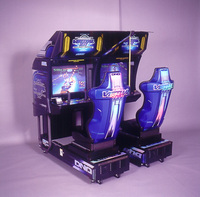 Other elements also had a functional makeover; dashing received the ability to curved and change mid-course. The latter was referred to affectionately as Watari dashing. The game even afforded aerial based dashing now.
Other elements also had a functional makeover; dashing received the ability to curved and change mid-course. The latter was referred to affectionately as Watari dashing. The game even afforded aerial based dashing now.
The biggest changes were twofold; V-armor and turbo attacks. V-armor was another layer of defence that deflected shots from a certain range. Compared this to the original were you could almost dash snipe an opponent on the other side of the map. The reason behind this was to keep players from running away from another and it actually worked quite well. Turbo attacks allowed the player to use the dash button in conjunction with a weapon trigger to power up certain attacks, this added another layer to the menu of attacks available to the player and deepened the game further.
Oratan also saw four major revisions, this was down to the further fevered following the first game had generated and the tournament scene was suitably ferocious. Balancing basically became a far greater issue.
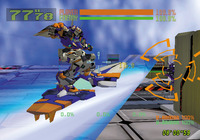 The M.S.B.S. 5.2 was the starting version and featured the most problems both technical and functional. This was swiftly followed by 5.4, with faster quick-stepping close combat, more available energy for weapons and a slew of other balancing tweaks across the board. Some maps even received reworking.
The M.S.B.S. 5.2 was the starting version and featured the most problems both technical and functional. This was swiftly followed by 5.4, with faster quick-stepping close combat, more available energy for weapons and a slew of other balancing tweaks across the board. Some maps even received reworking.
5.45 was the Dreamcast port and turned out to be a monumental challenge for the Oratan team. A lot of hardware reliances simply didn’t exist on the Dreamcast and the code base required extensive re-working, doubly so as the game had to run at 60 fps and still retain the visual accuracy from the arcade version.
Amazingly, the Dreamcast port received one of the best conversions the series has ever seen. It was practically faultless. It also featured online versus play over a 56k modem, from someone that played this originally in Japan it puts a lot of contemporary online games to shame.
The port also had a bespoke twinstick peripheral much like its Saturn cousin, which with Oratan’s increased input speed was absolutely essential. This isn’t to say you can’t play the game on the pad but with the sticks you can control far more precisely, allowing you to do things like this.
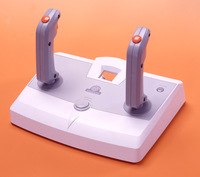 The final arcade version was 5.66 and released on Naomi hardware to allow for Dreamcast VMU integration and a partial porting of some of the codebase. 5.66 turned out to be a vast change to the previous iterations, with new rendering tech and new VRs (this generated large animation/art tasks for the team not to mention the monolithic task of balancing them properly).
The final arcade version was 5.66 and released on Naomi hardware to allow for Dreamcast VMU integration and a partial porting of some of the codebase. 5.66 turned out to be a vast change to the previous iterations, with new rendering tech and new VRs (this generated large animation/art tasks for the team not to mention the monolithic task of balancing them properly).
To think that 5.66 is basically the Dreamcast version in the arcade, would be a grievous misunderstanding. The dash speed had been increased and the game was totally balanced around the aforementioned twinsticks. So the precision and speed the player could command was far in advance of what the Dreamcast version offered.
This is why the newly announced console port of 5.66 is terrifying as there’s no news of any kind of twinstick peripheral. A pad couldn’t keep up on the Dreamcast version, which was a custom made port. This is specifically an arcade perfect port but without anything approaching arcade perfect controls.
It’s awful to think that the finest iteration of Oratan is being released to the public but with only half the functionality available to the gaming populace.
After 5.66 graced the Japanese arcades, many of the team left SEGA and took up jobs with Squaresoft (now Square Enix). Watari and Oguchi stayed but much of the expertise was no longer present, which is where the problems started.
Dennou Senki Virtual On Force (2001)
 Now with most of the team elsewhere, the sequel to Oratan had a tough life ahead of it. It only got worse as the new team now had to work with the notorious Hikaru board. If this had been a simple update to Virtual On, with two player versus intact, they might have had a chance of making something good. Unfortunately, the high concept from was that of four player. Now ignoring the awful functional ramifications for a moment, the technical nightmare of getting two VRs working in game was difficult enough but four?
Now with most of the team elsewhere, the sequel to Oratan had a tough life ahead of it. It only got worse as the new team now had to work with the notorious Hikaru board. If this had been a simple update to Virtual On, with two player versus intact, they might have had a chance of making something good. Unfortunately, the high concept from was that of four player. Now ignoring the awful functional ramifications for a moment, the technical nightmare of getting two VRs working in game was difficult enough but four?
The entire development was must have been an uphill struggle, with newer staff members desperately trying to get to grip with the code base, work with awkward hardware and deliver the impossible at the same time. All things considered, they did a pretty impressive job but unfortunately it followed hot on the heals of the near-perfect Oratan.
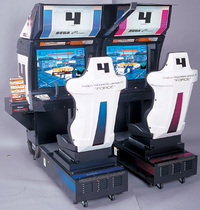 The big problem with Force was in three major areas; the four player didn’t work with Virtual On’s single lock dash based combat, the game avoided any and all dash freeze to hide the limitations of the lock-on system (allowing you to dodge everything, removing any of the original core tactics that had made the games such a success) and then a hugely unbalanced card system that awarded better players with even better VRs. The sum of all this practically killed Virtual On in the Japanese arcades.
The big problem with Force was in three major areas; the four player didn’t work with Virtual On’s single lock dash based combat, the game avoided any and all dash freeze to hide the limitations of the lock-on system (allowing you to dodge everything, removing any of the original core tactics that had made the games such a success) and then a hugely unbalanced card system that awarded better players with even better VRs. The sum of all this practically killed Virtual On in the Japanese arcades.
Force, in its defence, did try and utilise the four player setup as best it could though. Specifically, each team of two was split into a leader and a wingman. If the enemy team killed your leader, that resulted in a victory for them. If they killed the wingman, they lost their lock-on briefly as the leader could share some of their health to bring you back to life. This approach fostered a very cogent form of teamwork in the arcades, for the few that stuck with the game.
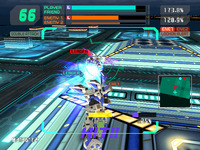 Yet for all the teamwork, the card system nullified any real kind of fanbase. As newer players were absolutely thrashed by veterans with better VRs. The card system was from Virtua Fighter 4 and whilst that purely offered aesthetic upgrades, for obvious balancing reasons, someone decided to copy Armored Core’s approach to customisation for Force, where upgrades would give functional variance. It was really very unfortunate, as the team focus was undermined by the possibility of having one veteran in a souped up VR trounce two newcomers.
Yet for all the teamwork, the card system nullified any real kind of fanbase. As newer players were absolutely thrashed by veterans with better VRs. The card system was from Virtua Fighter 4 and whilst that purely offered aesthetic upgrades, for obvious balancing reasons, someone decided to copy Armored Core’s approach to customisation for Force, where upgrades would give functional variance. It was really very unfortunate, as the team focus was undermined by the possibility of having one veteran in a souped up VR trounce two newcomers.
Even with Force’s dwindling numbers, there were a total of two revisions for the game. That said, things were only about to get much worse for the series.
Dennou Senki Virtual On Marz (2003)
 After Force tanked in the arcades, much of the new team were suitably jaded by the whole experience. So when a PlayStation 2 port was announced, many again left and others managed to work on something else. So without the core knowledge of how the arcade version worked, a new console specific team had to be assembled.
After Force tanked in the arcades, much of the new team were suitably jaded by the whole experience. So when a PlayStation 2 port was announced, many again left and others managed to work on something else. So without the core knowledge of how the arcade version worked, a new console specific team had to be assembled.
Again, the higher ups had their input stating that the reason for Force’s demise was that it lacked a compelling single-player experience (overlooking the fact that it was an arcade versus series of games). The new console team took this onboard and re-worked the Force codebase into something that would feature a greater emphasis on a single-player campaign.
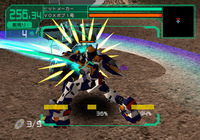 Now before I go off on one here, there is one element I haven’t covered yet about these games: between the releases of each game Watari had penned a serialised novel filling the narrative gaps. These were One Man Rescue and Fragmentary Passage. They explained a lot of the background for both Oratan and Force respectively yet there were still large mysteries unresolved. Marz was Watari’s attempt to answer a lot of the narrative inconsistencies to the Japanese fan base.
Now before I go off on one here, there is one element I haven’t covered yet about these games: between the releases of each game Watari had penned a serialised novel filling the narrative gaps. These were One Man Rescue and Fragmentary Passage. They explained a lot of the background for both Oratan and Force respectively yet there were still large mysteries unresolved. Marz was Watari’s attempt to answer a lot of the narrative inconsistencies to the Japanese fan base.
Unfortunately, for everyone else, not only did we get a comedically awful localisation but the historical context didn’t exist outside of Japan (as neither of the sidestories were published abroad).
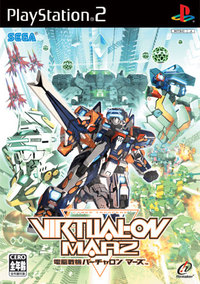 That aside, Marz wasn’t shaping up to be that good. Many of the game’s environments were long and winding, yet the original Force lock-on system was sadly still present. This meant you’d be locking on to an enemy kilometres away in another canyon whilst you were trying to negotiate your way through a veritable maze.
That aside, Marz wasn’t shaping up to be that good. Many of the game’s environments were long and winding, yet the original Force lock-on system was sadly still present. This meant you’d be locking on to an enemy kilometres away in another canyon whilst you were trying to negotiate your way through a veritable maze.
The whole game was infuriatingly like this and what with Force’s ported sluggish mechanics the final game wasn’t exactly great. The real nail in the coffin was down to the fact that Marz was the first console game not to receive a twinstick peripheral. Considering that Force relied so heavily on quick jump cancels, having to attempt that on a pad with woolly dual analogue controls made the game a lot harder than it needed to be.
The only way to for me to play Marz properly was to complete the game on Ultimate difficulty, which unlocked the Shirokis Temjin (the VR at the beginning of this article in case you’re wondering). A wonderfully quick VR that basically made the game play like Oratan again. It also helped having a custom built pair of twinsticks.
The final level was noteworthy though as it reversed gravity, which was functionally quite interesting. If only the rest of the game had experimented with different mechanics and reduced the size of the environments, Marz may have been a bit more worthwhile.
Virtual Off?
So what happens to the series now? After the one two punch of Force and Marz, the series is still on its knees. Having Temjin et al appear in Super Robot Wars (both in Alpha 3 and now K) only confirms the fact that the series is in dire straights with its fanbase, as the cameos are a feeble attempt to generate interest again.
A digital download version of Oratan 5.66 may appear on the surface to be a beneficial thing but the lack of twinsticks only shows that this is an exercise in kudos generation rather than anything worthwhile for the series. Not to mention that playing 5.66 on pad will be pretty heartbreaking, as you just won’t be able to control the game properly.
Of all the mecha games I love, Virtual On is and always will be my favourite. Instead of approaching mecha as something literal, the team approached how the combat would work instead; basically what the mecha do rather than what they are. That insight is probably the most inspiring aspect of the original games. I just hope one day that insight will re-surface.
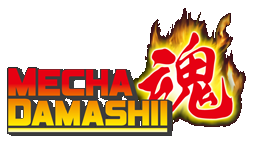
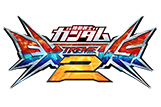
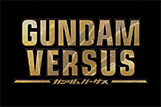








[…] God and all-round nice guy Ollie Barder. As the preeminent speaker on all things Virtual On, his feature article on the history of the series (including Force and its ill-fated console counterpart, Marz) sheds […]
I know it’s been ages, but some things need to be said now.
5.66 on the 360 controller has proven to work surprisingly well [noticably better than 5.45 on the DC, the LB/RB mean that you can actually curve dash on a pad without some nasty movement from d-pad to stick], and there are 360 twinsticks avaliable now.
The real big problem with 5.66 on the 360 is the lack of splitscreen — Virtual On’s big focus is on human competition. The online scene will eventually die [and Live will go away for the 360 one day when MS releases its next system], but people will still have VOOT on their 360 and want to introduce it to some friends.
It’s interesting to see how VO’s development was — I didn’t really expect that much of the design came about from the Model 2 limitations, especially after seeing VF2 and the like, with its fluid animation and rather quick combat [admittedly not nearly up to Virtual On speed].
Especially with the bit on how dashing worked, I’m wondering about the underlying details on how you’d even be able to hit your opponent in dash if the hardware hadn’t updated your position until the end.
The twinsticks’ rationale seems more sound than I thought. Before, I thought it was designed that way because of how Cyber Sled worked, and it seemed like a good fit.
I always knew there was something vastly different about Saturn VO, but I couldn’t really put my finger on some of the more major changes. Great fun still [after getting used to the controls, and even though the Saturn version has twinsticks, Saturn VO is very much a pad designed game, even if being based on Arcade VO means that it has to make some odd control decisions], but doesn’t beat VO in the arcade [definitely close, but the twinsticks feel like you’re piloting an actual mech, which feels great].
The DC pad was pretty awful for Oratan, though the Saturn was better (oddly). However, the PS2 and 360 pads are still worse than the TwinSticks. They just are.
[…] that in mind I am hoping that we may yet see another Virtual On game, especially as it is the 20th Anniversary of the series this […]
[…] that in mind I am hoping that we may yet see another Virtual On game, especially as it is the 20th Anniversary of the series this […]
[…] I just want to see interesting games like Virtual On (shown above) given another shot especially as it is the series’ 20th anniversary this […]
[…] I just want to see interesting games like Virtual On (shown above) given another shot especially as it is the series’ 20th anniversary this […]
[…] I just want to see interesting games like Virtual On (shown above) given another shot especially as it is the series’ 20th anniversary this […]
[…] I just want to see interesting games like Virtual On (shown above) given another shot especially as it is the series’ 20th anniversary this […]
[…] reason why I am excited about all of this is that it might mean we could get new Virtual On […]